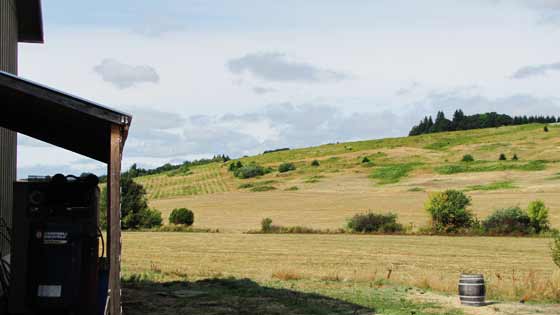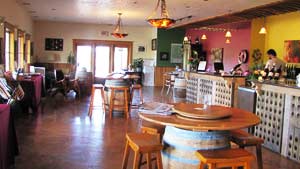Carleton, Oregon. Sparkling wines are relatively new in the Willamette Valley. Only a tiny number of wineries within this region are producing wines with carbonation, mostly using the high-quality, French “Methode Champenoise” process where a secondary fermentation occurs in the bottle, as opposed to the cheaper method of just adding carbon dioxide gas to the wine after bottling. Chris Berg, the current winemaker for the Laurel Ridge Winery, is one of the few local winemakers who specializes in making “Methode Champenoise” style sparkling wines.

Berg, who also produces wine under his own label, Roots, from pinot noir grapes grown on his nearby 20-acre vineyard, became interested in the culinary arts after high school, but then switched over to becoming a winemaker. For Berg, winemaking has similar objectives to cooking: “You take your raw ingredients and add your spin on it, without trying to detract from the product itself”. As he continues, ”With me and champagne [style wines], I like it for the excitement of where it starts, to where it finishes, and helping it along, trying not to take away from what it was originally.”
Not all wines can be made into sparkling wine, it depends mostly upon the grape varietal, the climate conditions for a particular vintage, and the degree of ripeness when the grapes are harvested. In the Willamette Valley, the vast majority of sparkling wines come from just 4 different grape varietals: Pinot Noir; Pinot Meunier; Chardonnay; and Reisling.
Chris Berg says that a good sparkling has to tell where it comes from, “be it a vineyard down the street, or the Willamette Valley”, a good sparkling wine provides a “sense of place”. Second, the varietal characteristic, either a pinot or a chardonnay, must be identifiable in the flavor. And finally, stylistically, how well the sparkling wine measures up to the final objectives for that vintage. Does it have enough creaminess, and well rounded flavor? Or, if the objective is for it to be “vibrant and lively,” with a more focused flavor, does it have enough of those characteristics?
Visit Yamhill Valley Wines for their “Wines of the Valley” series that features the history, quality and diversity of the Yamhill Valley’s flourishing wine industry. For the introductory video, along with the video series list, check out the first post on CUPS: The Yamhill Valley Wine Region of Oregon
Most of the videos featured on Cooking Up a Story were produced, filmed, and edited by Rebecca Gerendasy. Fred Gerendasy contributed as a writer to many of the posts and occasionally as the interviewer. Visit Rebecca Gerendasy Clay – Art and Fred Gerendasy Photography to see their current work.

